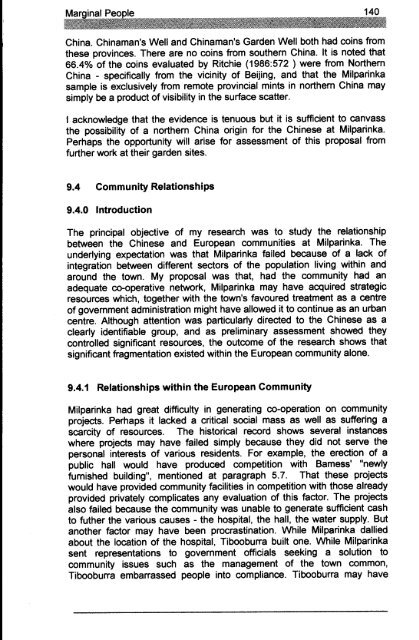Adec Preview Generated PDF File - The Sydney eScholarship ...
Adec Preview Generated PDF File - The Sydney eScholarship ...
Adec Preview Generated PDF File - The Sydney eScholarship ...
You also want an ePaper? Increase the reach of your titles
YUMPU automatically turns print PDFs into web optimized ePapers that Google loves.
China. Chinaman's Well and Chinaman's Garden Well both had coins from<br />
these provinces. <strong>The</strong>re are no coins from southern China. It is noted that<br />
66.4% of the coins evaluated by Ritchie (1986:572 ) were from Northern<br />
China - specifically from the vicinity of Beijing, and that the Milparinka<br />
sample is exclusively from remote provincial mints in northern China may<br />
simply be a product of visibility in the surface scatter.<br />
I acknowledge that the evidence is tenuous but it is sufficient to canvass<br />
the possibility of a northern China origin for the Chinese at Milparinka.<br />
Perhaps the opportunity will arise for assessment of this proposal from<br />
further work at their garden sites.<br />
9.4 Community Relationships<br />
9.4.0 Introduction<br />
<strong>The</strong> principal objective of my research was to study the relationship<br />
between the Chinese and European communities at Milparinka. <strong>The</strong><br />
underlying expectation was that Milparinka failed because of a lack of<br />
integration between different sectors of the population living within and<br />
around the town. My proposal was that, had the community had an<br />
adequate co-operative network, Milparinka may have acquired strategic<br />
resources which, together with the town's favoured treatment as a centre<br />
of government administration might have allowed it to continue as an urban<br />
centre. Although attention was particularly directed to the Chinese as a<br />
clearly identifiable group, and as preliminary assessment showed they<br />
controlled significant resources, the outcome of the research shows that<br />
significant fragmentation existed within the European community alone.<br />
9.4.1 Relationships within the European Community<br />
Milparinka had great difficulty in generating co-operation on community<br />
projects. Perhaps it lacked a critical social mass as well as suffering a<br />
scarcity of resources. <strong>The</strong> historical record shows several instances<br />
where projects may have failed simply because they did not serve the<br />
personal interests of various residents. For example, the erection of a<br />
public hall would have produced competition with Bamess' "newly<br />
furnished building", mentioned at paragraph 5.7. That these projects<br />
would have provided community facilities in competition with those already<br />
provided privately complicates any evaluation of this factor. <strong>The</strong> projects<br />
also failed because the community was unable to generate sufficient cash<br />
to futher the various causes - the hospital, the hall, the water supply. But<br />
another factor may have been procrastination. While Milparinka dallied<br />
about the location of the hospital, Tibooburra built one. While Milparinka<br />
sent representations to government officials seeking a solution to<br />
community issues such as the management of the town common,<br />
Tibooburra embarrassed people into compliance. Tibooburra may have




